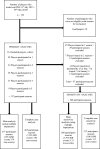Can prognostic factors for indirect muscle injuries in elite football (soccer) players be identified using data from preseason screening? An exploratory analysis using routinely collected periodic health examination records
- PMID: 36693686
- PMCID: PMC9884927
- DOI: 10.1136/bmjopen-2021-052772
Can prognostic factors for indirect muscle injuries in elite football (soccer) players be identified using data from preseason screening? An exploratory analysis using routinely collected periodic health examination records
Abstract
Background: In elite football, periodic health examination (PHE) may be useful for injury risk prediction.
Objective: To explore whether PHE-derived variables are prognostic factors for indirect muscle injuries (IMIs) in elite players.
Design: Retrospective cohort study.
Setting: An English Premier League football club.
Participants: 134 outfield elite male players, over 5 seasons (1 July 2013-19 May 2018).
Outcome and analysis: The outcome was any time-loss, lower extremity index IMI (I-IMI). Prognostic associations were estimated using odds ratios (ORs) and corresponding statistical significance for 36 variables, derived from univariable and multivariable logistic regression models. Missing data were handled using multiple imputation. Non-linear associations were explored using fractional polynomials.
Results: During 317 participant-seasons, 138 I-IMIs were recorded. Univariable associations were determined for previous calf IMI frequency (OR 1.80, 95% CI 1.09 to 2.97), hamstring IMI frequency (OR 1.56, 95% CI 1.17 to 2.09), if the most recent hamstring IMI occurred >12 months but <3 years prior to PHE (OR 2.95, 95% CI 1.51 to 5.73) and age (OR 1.12 per 1-year increase, 95% CI 1.06 to 1.18). Multivariable analyses showed that if a player's most recent previous hamstring IMI was >12 months but <3 years prior to PHE (OR 2.24, 95% CI 1.11 to 4.53), this was the only variable with added prognostic value over and above age, which was a confirmed prognostic factor (OR 1.12 per 1-year increase, 95% CI 1.05 to 1.18). Allowing non-linear associations conferred no advantage over linear associations.
Conclusion: PHE has limited use for injury risk prediction. Most variables did not add prognostic value over and above age, other than if a player experienced a hamstring IMI >12 months but <3 years prior to PHE. However, the precision of this prognostic association should be confirmed in future.
Trial registration number: NCT03782389.
Keywords: Musculoskeletal disorders; REHABILITATION MEDICINE; SPORTS MEDICINE.
© Author(s) (or their employer(s)) 2023. Re-use permitted under CC BY. Published by BMJ.
Conflict of interest statement
Competing interests: None declared.
Figures
Similar articles
-
Cost-effectiveness of using prognostic information to select women with breast cancer for adjuvant systemic therapy.Health Technol Assess. 2006 Sep;10(34):iii-iv, ix-xi, 1-204. doi: 10.3310/hta10340. Health Technol Assess. 2006. PMID: 16959170
-
Signs and symptoms to determine if a patient presenting in primary care or hospital outpatient settings has COVID-19.Cochrane Database Syst Rev. 2022 May 20;5(5):CD013665. doi: 10.1002/14651858.CD013665.pub3. Cochrane Database Syst Rev. 2022. PMID: 35593186 Free PMC article.
-
Use of endoanal ultrasound for reducing the risk of complications related to anal sphincter injury after vaginal birth.Cochrane Database Syst Rev. 2015 Oct 29;2015(10):CD010826. doi: 10.1002/14651858.CD010826.pub2. Cochrane Database Syst Rev. 2015. PMID: 26513224 Free PMC article.
-
Comparison of Two Modern Survival Prediction Tools, SORG-MLA and METSSS, in Patients With Symptomatic Long-bone Metastases Who Underwent Local Treatment With Surgery Followed by Radiotherapy and With Radiotherapy Alone.Clin Orthop Relat Res. 2024 Dec 1;482(12):2193-2208. doi: 10.1097/CORR.0000000000003185. Epub 2024 Jul 23. Clin Orthop Relat Res. 2024. PMID: 39051924
-
[Volume and health outcomes: evidence from systematic reviews and from evaluation of Italian hospital data].Epidemiol Prev. 2013 Mar-Jun;37(2-3 Suppl 2):1-100. Epidemiol Prev. 2013. PMID: 23851286 Italian.
References
-
- McCall A, Carling C, Davison M, et al. . Injury risk factors, screening tests and preventative strategies: a systematic review of the evidence that underpins the perceptions and practices of 44 football (soccer) teams from various premier leagues. Br J Sports Med 2015;49:583–9. 10.1136/bjsports-2014-094104 - DOI - PMC - PubMed
Publication types
MeSH terms
Associated data
Grants and funding
LinkOut - more resources
Full Text Sources
Medical

